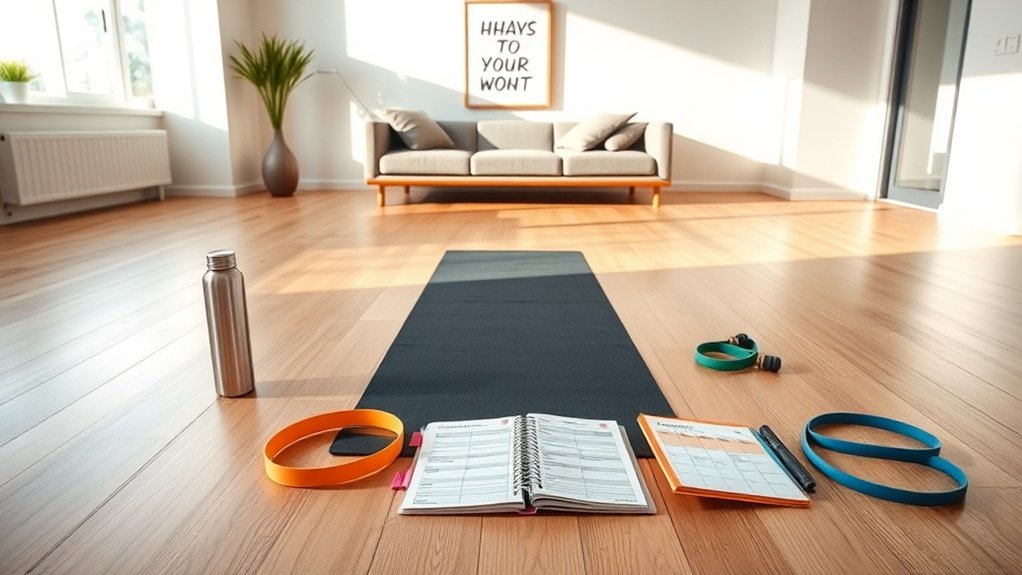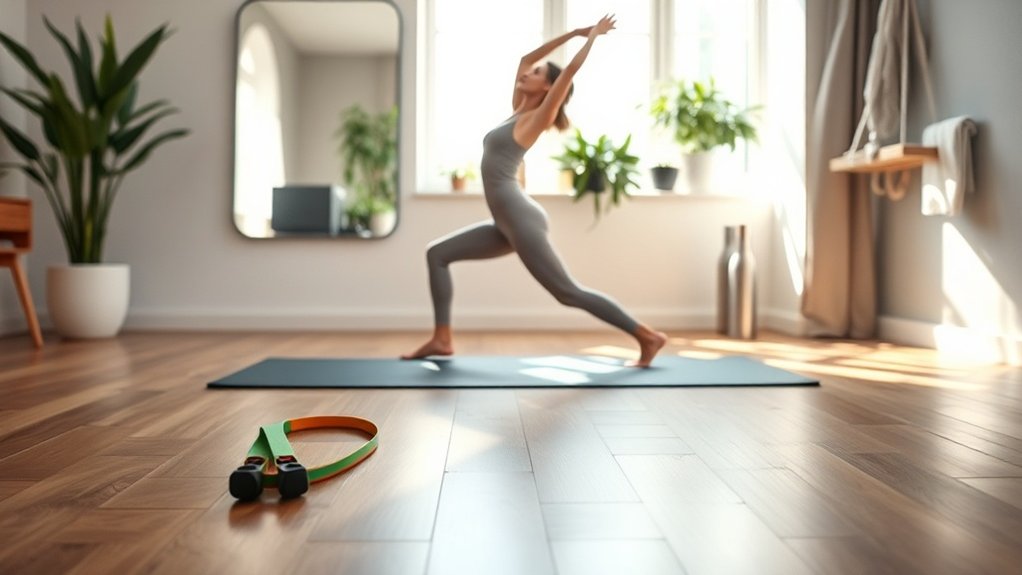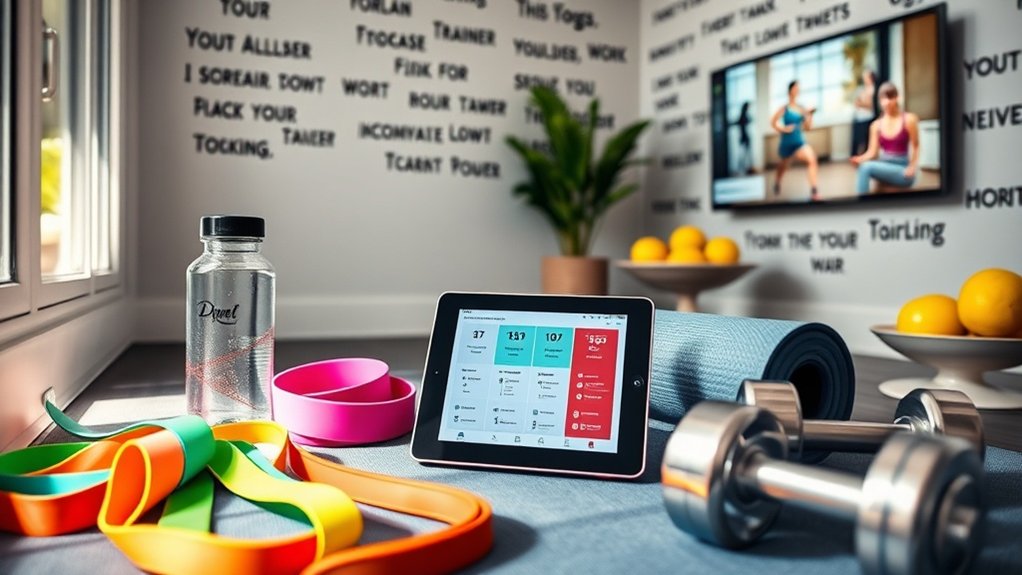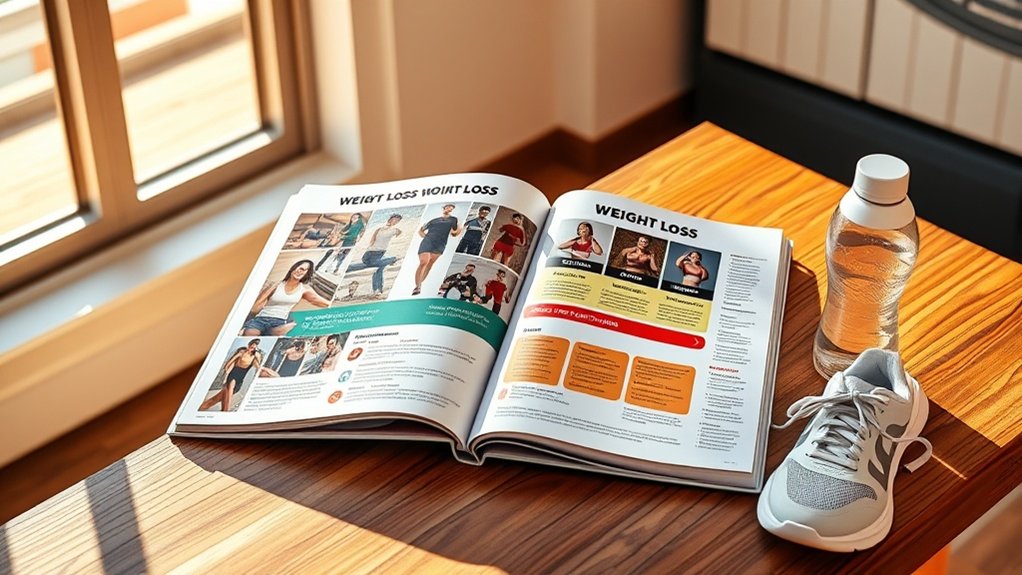You’ll start by evaluating your baseline with simple tests like push-ups and planks, then set SMART goals that match your current abilities. Begin with foundational movements like knee push-ups and assisted squats, focusing on proper form before progressing to intermediate variations. Structure your week with 3-5 training days targeting major muscle groups, and apply progressive overload by increasing repetitions or slowing your tempo every two weeks. Consistent warm-ups and cool-downs prevent injuries while maximizing results, and the complete progression system below guarantees you’ll continue advancing safely.
How to Assess Your Fitness Level and Set Home Workout Goals

Before you can design an effective home workout plan, you need an honest assessment of where you currently stand. Assess your fitness level by performing basic exercises like push-ups, squats, and planks across different muscle groups. Record your repetitions and duration to establish your baseline strength and endurance.
Next, use the SMART framework to set workout goals that are specific, measurable, achievable, relevant, and time-bound. This approach provides focus and accountability. For example, aim to complete 20 push-ups within four weeks rather than simply “getting stronger.”
Track your progress by monitoring repetitions, exercise duration, and body measurements. Reassess every few weeks to adjust your intensity and goals accordingly.
This systematic approach identifies your strengths and weaknesses while promoting continuous improvement throughout your fitness journey.
Progressive Bodyweight Exercise Library: Beginner to Advanced Variations
Once you’ve established your baseline fitness level, a progressive bodyweight exercise library becomes your roadmap for systematic improvement.
Your workout program should incorporate beginner to advanced variations that support systematic strength training progression.
Start with foundational movements like assisted squats and knee push-ups, prioritizing proper form over intensity. These beginner bodyweight exercises build essential movement patterns while minimizing injury risk.
As you advance, shift to intermediate variations—standard push-ups and walking lunges—that increase muscle engagement and cardiovascular demands.
Advanced practitioners can tackle one-legged squats and chin-ups, which require exceptional coordination and power.
Apply progressive overload principles throughout your exercise routine by increasing repetitions, adding rounds, or advancing to harder variations.
This structured approach guarantees your home workouts continuously challenge your body, promoting sustained muscle growth and functional fitness development.
Structuring Your Weekly Home Workout Split and Schedule

Having mastered individual exercise progressions, you’ll need to organize these movements into a weekly framework that maximizes results while preventing burnout.
Your structured plan should align with your fitness levels: beginners benefit from 3-day full-body training targeting major muscle groups, while intermediate practitioners can adopt upper/lower or push/pull/legs splits across 4-5 days.
This training program requires 2-3 rest days weekly for intense bodyweight workout sessions, or 1-2 for lighter routines. Include active recovery days with walking or yoga to improve circulation between demanding sessions.
Track your weekly workout schedule metrics—research shows personalized trainer-guided monitoring improves strength gains by 23% and endurance by 18%.
Adjust rest time and training frequency based on performance data, making certain your workout plan evolves with your advancing capabilities.
Preventing Plateaus: Progressive Overload Strategies Without Equipment
Progressive overload remains the cornerstone of continuous fitness improvement, yet it’s achievable without a single piece of equipment when you apply strategic manipulation of training variables. To prevent plateaus in home workouts, you’ll systematically increase training demands through exercise variations, volume progression, and tempo modifications that stimulate muscle growth.
| Strategy | Implementation |
|---|---|
| Volume Progression | Increase repetitions or sets by 5-10% every two weeks |
| Exercise Variations | Shift from standard push-ups to one-legged variations |
| Time Under Tension | Slow the eccentric phase to 3-4 seconds |
| Compound Movements | Incorporate burpees and jump squats for intensity |
Track progress by recording completed repetitions and circuit completion times. This data-driven approach guarantees you’re consistently challenging your muscles differently, preventing adaptation while maintaining safe progression toward your fitness goals.
Essential Warm-Up, Cool-Down, and Mobility Protocols for Home Training

Your progressive overload strategies won’t deliver ideal results if you’re training on unprepared muscles and joints. A structured routine begins with a five-minute warm-up featuring dynamic movements like marching in place, arm swings, and easier variations of your upcoming exercises.
This raises your heart rate while improving joint range of motion and flexibility through movements like leg swings and torso twists.
Your cool-down is similarly critical for injury prevention and muscle recovery. Gradually lower your heart rate, then stretch the major muscle groups you’ve worked.
This mobility-focused approach boosts your home training effectiveness by preparing your body for intense work and promoting proper recovery afterward.
Consistent warm-up and cool-down protocols considerably reduce injury risk while maximizing your workout’s long-term benefits.
Frequently Asked Questions
What Is the 3-3-3 Rule for Workout?
The 3-3-3 rule boosts workout efficiency by performing three sets of three exercises targeting different muscle groups. You’ll achieve fitness goals through exercise variety, combining strength building and cardio benefits while maintaining home routines that support progressive adaptation and recovery.
What Is the 5 4 3 2 1 Workout Method?
You’ll complete five sets of one exercise, four sets of another, three sets of a third, two sets of a fourth, and one set of a fifth. This 5-4-3-2-1 structure delivers efficient, beginner-friendly workouts with measurable progress tracking.
What Is the 4 8 12 Rule?
The 4-8-12 rule structures your bodyweight exercises into four sets of 8-12 reps, promoting workout consistency and progressive intensity. You’ll achieve fitness goals through exercise variety while fitness tracking monitors your improvements, assuring safe progression and sustained motivation techniques.
What Is the 3 2 1 Rule in Gym?
You’ll follow three strength training exercises, two cardio benefits-focused movements, and one flexibility routine per session. This progression-oriented approach supports your fitness goals, builds workout consistency, and creates a mindset shift toward balanced training and recovery techniques.



